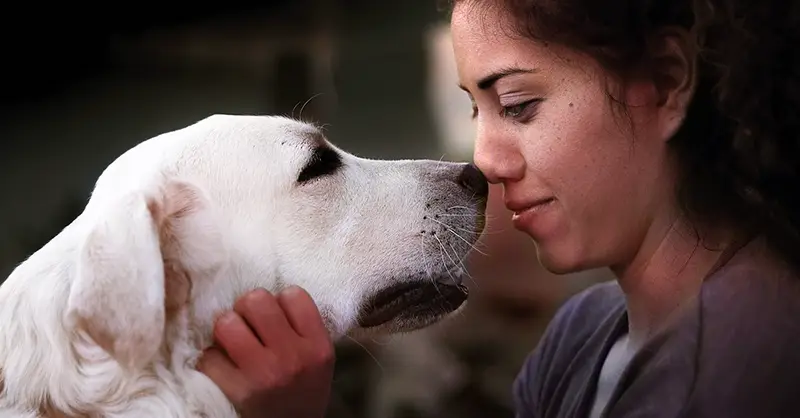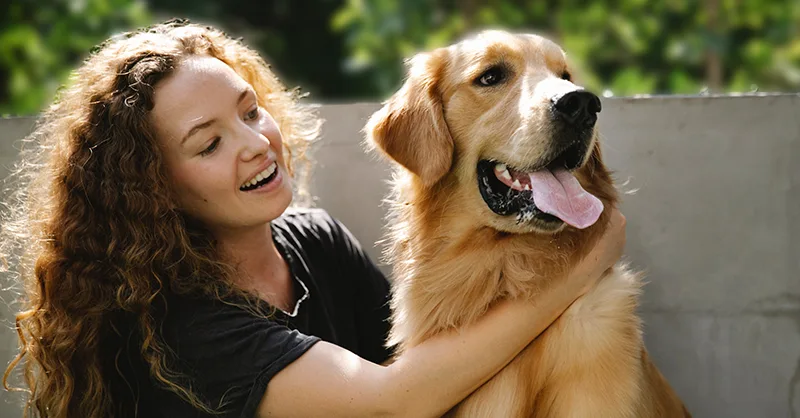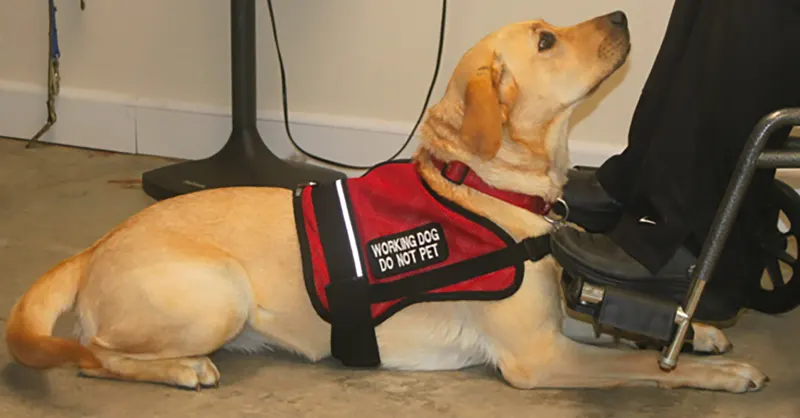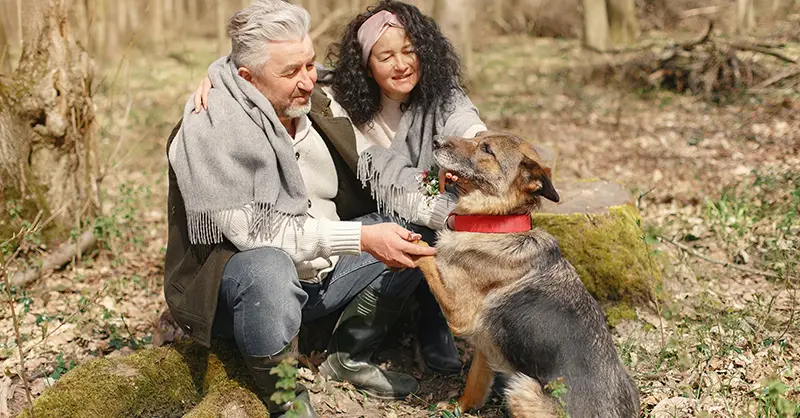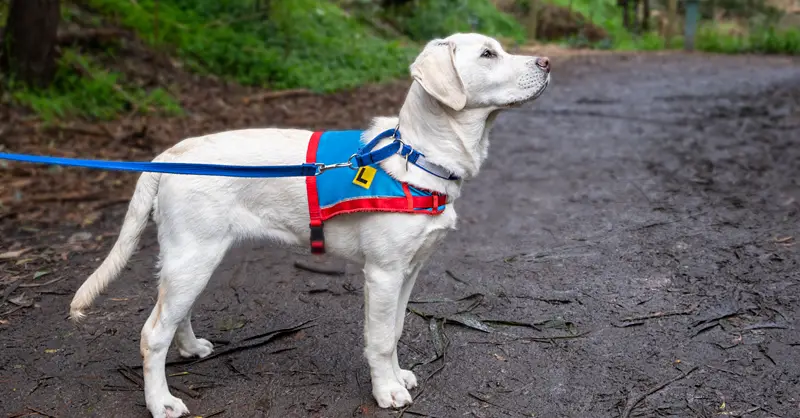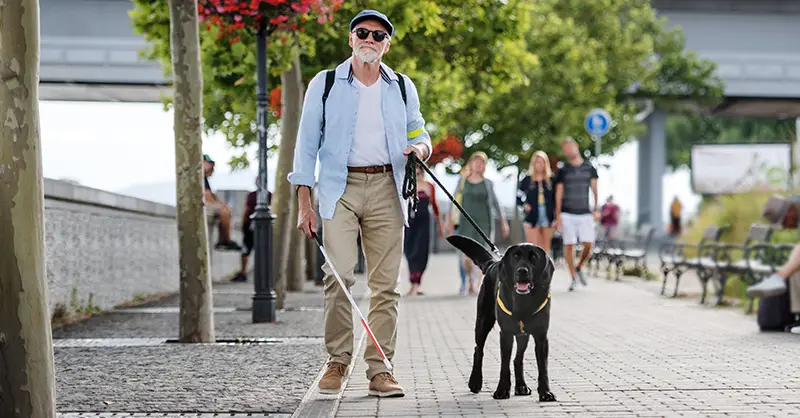Archive for the ‘Service Dog Tips’ Category
Many seniors have mobility or other issues that could benefit from having a service dog for specific assistance. But not everyone knows there are different service dogs that help people with different challenges. Each type of service dog has a specific purpose.
Here are some of the most common types of service dogs for seniors:
Hearing Dogs Diabetic Alert Dogs Guide Dogs Mobility Assistance Dogs Seizure Response Dogs Hearing DogsThese service dogs are trained to help their humans who are deaf or hard of hearing. They alert their handlers to sounds like smoke alarms, ringing doorbells, timers and alarm clocks, and ringing phones. Poodles, Golden Retrievers, Pomeranians, and Cocker Spaniels are commonly chosen for their sharp hearing and responsiveness to training. However, any dog with good hearing and an obedient nature can be a hearing dog. When the dog hears a sound that the handler needs to know about, they will get the attention of their handler by pawing or performing any other trained activity.
Diabetic Alert DogsDiabetes is a widespread problem in older adults. It is treatable, but some seniors may have difficulty controlling their blood sugar. Others have sudden changes in blood sugar even with treatment and monitoring. Diabetic alert dogs can help in this situation by alerting their handler if their blood sugar gets too high or too low. But how do they do this? High or low blood sugar causes the body to release chemicals that have a strong odor to dogs — even though this odor is undetectable to the human nose! Diabetic alert dogs can be trained to alert their handler or trigger an alarm if their handler needs help.
Different types of service dogs can help seniors deal with age-related and other disabilities. Guide DogsMost people are familiar with guide dogs; they assist the visually impaired. They are trained to lead their handlers as they navigate the world, preventing them from walking into objects or other people. Many guide dogs can lead their handler all over the city and back home again, including riding on public transit. (Service dogs are allowed in public places, including on planes and other modes of public transportation. If you have difficulty convincing your ride-share driver, read this article.) People often think of German Shepherds when they think of guide dogs, but any dog that is easy to train and has the proper temperament can do the job.
Mobility Assistance DogsMobility assistance dogs are great for seniors with difficulty moving or getting around. Large, strong breeds are preferred, as these dogs have to do various tasks, from turning lights on and off to pulling a wheelchair. They may also support a handler who needs assistance standing or using other mobility aids like crutches, canes, or walkers. Like guide dogs, mobility assistance dogs tremendously help seniors who want to maintain their independence. Some seniors have difficulty doing things around the house but don’t want to move into assisted living. A mobility assistance dog can help them with moving and daily tasks, allowing the seniors to continue living alone and going out, shopping, and socializing.
Seizure Response DogsSeizure response dogs are trained to help handlers who have epilepsy. Although epilepsy can be treated with medication, some patients still have unpredictable seizures. A seizure alert dog helps in several ways. Some will place themselves between a falling handler and the floor to prevent injury. They may also be trained to drag their handler to a safe location if the seizure occurs in an unsafe place — like on the road, in the shower or bathtub, or in other areas that could pose an imminent danger. Additionally, they can be trained to alert others if their handler needs medical attention.
A Service Dog for Any Senior DisabilityAs life gets slower and presents more obstacles to citizens of higher age, a service dog can make a senior’s daily activities a little easier and safer. While there are many types of service dogs for various disabilities, any potential handler should be aware of the responsibilities of owning a service dog. Even the most practical and well-trained service dog is a dog after all and needs grooming and exercise to be healthy and able to perform their tasks. Getting a young, energetic service dog may feel overwhelming to an older person as the dog will have to be under the control of their handler at all times, especially when out and about. Therefore, any senior considering getting a service dog should make a well-informed decision on the type and breed of service dog they need. And they should be sure that they would have the support of someone else to take care of the dog if the responsibilities get overwhelming. But once the service dog is attuned to their handler’s needs, life will no doubt make a turn for the better, and both will enjoy the company and taking care of each other.
Have you ever asked yourself, ‘How do I get my dog to stop pulling on the leash‘? You are not alone. This is a common question. You may have noticed other dogs walking calmly beside their handler while your dog tugs impatiently on the leash.
In this article, we’ll show you how to teach your service dog in training to keep pace with you during walks.
Getting Started Step 1 – Leash and TreatsYou can begin leash training in your yard with a 10-20 foot leash and treats your dog likes (small pieces of meat or fruit usually work if you don’t have dog treats or any food your dog likes). It’s best to use a front harness instead of a neck collar.
Equipping your service dog in training with a comfortable harness, like this reflective service dog harness vest, will add to the success of the leash training.Some big dogs may do better with a head collar. These may also discourage pulling because when the dog strains at the lead, the head collar puts gentle downward pressure on the dog’s head.
Step 2 – Establish a HabitFirst, decide which side you want your dog to walk on, then always practice with the dog on that side. This will be the side you offer treats on, encouraging the dog to stay there. Walk around your yard, rewarding your dog with a treat when they stay by your side. At first, give them a treat every few steps for staying with you. You can do this less often as the dog improves, but they should always get their reward while doing the behavior you want to reinforce — in this case, staying by your side.
Sometimes the dog will lag or wander. When this happens, say, “Let’s go” or “Come on” while slapping your thigh on the treat side. This should get your dog’s attention. As soon as your service dog catches up with you, give them a treat. Give more treats every few steps as the dog continues to stay with you.
Keeping a training log will help with analyzing the progress of your service dog’s leash training. Download this free sample Service Dog Training Log, provided by Service Dog Certifications, to get started.
Step 3 – Dealing with StubbornnessWhat if your service dog in training is stubborn? If the dog doesn’t respond to “Let’s go” or the slap on your thigh, pull the leash taut and give it a gentle tug. The idea is to remind the dog of your presence and make it more difficult for them to ignore you. However, don’t force or pull the dog to you! Let them catch up on their own. Offer praise when they finally come toward you, then take pressure off the leash.
Step 4 – Set BoundariesDogs need time and space to relieve themselves when walking, but you want to be able to decide when and where they do it (not on the neighbor’s rose bush!). Choose a time when you would typically give a food reward, and instead say, “Sniff” or “Potty.” This freedom to explore is a reward, too – so if the dog tugs on the lead, say, “Let’s go,” and end the free time. Do this also when your service dog is finished with relieving, and you’re ready to end the free time. Then continue walking.
Getting Out of the YardOnce your service dog in training has mastered the previous exercises, start shrinking the size of the rope or leash until you’re at about six feet of lead. Mix things up by walking faster, slower, or in a different direction. If your service dog stays by your side, you can move on to a sidewalk. If not, continue training until your service dog has it down.
Once on a public sidewalk, there will be more distractions, so have extra treats on hand. Continue training the way you did in your yard, saying, “Let’s go,” and tugging on the lead if your dog gets distracted and starts pulling. When they return to your side, reward them with a big treat for ignoring an extra-interesting distraction, like a cat, a squirrel, or a car to chase.
What if my dog keeps trying to trip me?If your dog keeps getting underfoot, stomp or shuffle your feet, bringing them to the dog’s attention.
Remember, if you’re happy and upbeat during training, chances are your service dog in training will be too.
ServiceDogCertifications.com
Pay Attention to Your Service Dog’s AbilitySome dogs may figure out that simply pulling away and then coming back to you is an easy way to get a treat. Sneaky dog! If you feel your dog is playing you for treats, stop giving a treat when the dog returns, and instead, give one for staying by your side for a longer period of time without interruption.
As with any training, leash training a new service dog takes time and patience. If you’re unable to get your dog to follow or you don’t have the proper space and time to conduct the service dog training yourself, don’t be afraid to reach out to a friend with service dog training experience or even a professional. As your fully-trained service dog will be able to follow you into any public area – even places where usually no dogs are allowed –, leash training is an important factor in getting your service dog to pass the required public access test.
Show that your Service Dog has mastered the Public Access Test.Get your Handler-Certified Public Access Test certificate.Service dogs have been used since the mid-1940s for those with visual impairments. Today, the service dog has expanded into an even more significant role, especially for seniors, so much so that most senior living communities openly welcome these furry members.
Let’s explore the benefits of a service dog for seniors.
What is a Service Dog?There may be some confusion between a service dog, a therapy dog, and an emotional support animal. A service dog is specifically trained to perform a task for its human handler. A therapy animal visits people in hospitals or nursing homes, and an emotional support animal is an untrained animal that offers comfort to a person, usually for mental or emotional health disorders. All these animals play an important role for the right individual.
To own a service dog, a senior must have a qualifying disability and need for a task trained service dog that assists with symptoms of that disability.
Service dogs are protected under federal laws. The Americans with Disabilities Act (ADA), for example, enables service dogs to follow their handler anywhere accessible to the general public, even in areas where other dogs are not allowed. Service dogs are provided access because they are critical to the health of their handler.
Other federal laws protecting service dogs are:
Housing and Urban Development’s Fair Housing Act (FHA). Under the FHA, service dogs can live with their handlers in “no pets allowed” housing, free from fees and discrimination. Transportation Department’s Air Carrier Access Act (ACAA). The ACAA allows service dogs to fly in an airplane’s cabin with their handler without fees.Along with these federal laws, some states also have laws that pertain to service dogs.
Show everyone that the rights of your service dog should be respected. Get your service dog registered below.
Service Dogs and the Visually ImpairedThe Guide Dog Foundation was created in 1946 with a specific goal:
“to allow visually impaired individuals to live without boundaries.”
This program works tirelessly to match the perfect dog to the individual based on personality, mobility, physical needs, and lifestyle. When the right service dog and handler are paired, it creates an unbreakable bond.
But this is just one area where the service dog is invaluable. Seniors without visual impairment may also have a need for a service dog.
Service Dogs and the Aging BodyAs we age, we are prone to developing other disabilities such as impaired hearing, diabetes, seizure disorders, and limited mobility. Service dogs can be specifically trained to aid seniors in all these areas, such as alerting the handler to a drop in blood sugar, an oncoming seizure, or simply the telephone ringing or the sound of the doorbell. Larger service dogs are also perfect for providing support with mobility issues or picking up dropped items.
Service Dogs and the Aging BrainIt’s been proven that just spending time with a dog can lower blood pressure, release feel-good endorphins, and reduce anxiety and depression.
As a person ages, they may experience some mental health issues, from a mild case of forgetfulness to dementia or Alzheimers. Some seniors may also suffer from depression, anxiety, or PTSD. Service dogs can reduce or even alleviate some of the symptoms of these conditions.
A study of people with Alzheimer’s concluded that patients who spent time with a simple therapy dog could recount memories and feelings, which helped to improve their overall quality of life.
To further this idea, the Dementia Dog Project that was developed by students at the Glasgow School of Art and supported by Alzheimer Scotland, Dogs for the Disabled, and Guide Dogs Scotland, showcases that:
“Service dogs can help people with dementia maintain their waking, sleeping, and eating routine, remind them to take medication, improve confidence, keep them active and engaged with their local community, as well as providing a constant companion who will reassure {them} when facing new and unfamiliar situations.”
Service Dogs and the Senior’s Mental HealthService dogs can also be trained to assist with mental health disabilities. For example, they can remind handlers to take medication, provide pressure therapy during moments of crisis or break dissociative “spells” by barking or licking. Service dogs also provide seniors with other mental health benefits, including;
Enhanced confidence and self-esteem Decreased levels of anxiety and depression A decrease in some senior-related behavioral issues A sense of comfort and safety Increase in socialization with other people. A service dog can be beneficial to many different physical and mental health issues of seniors. Service Dogs and the Senior’s Physical HealthSome seniors have trouble maintaining physical activity. Service dogs can be trained to assist with limitations in movement. Service dogs can also help promote activity by going for walks each day and encouraging the person to play with the canine.
Other potential physical benefits of a service dog are:
Increase in muscle tone and strength Increase in bone strength Improved balance Improved circulation Improved overall cardiovascular health – lowered risk of heart attacks and an increased survival rate among patients who have experienced one. Seniors and Service DogsIf you or a loved one is a senior, you may consider getting a service dog. These specially trained canines can help with everyday tasks, alert to oncoming medical issues, or be there to lend a furry paw for comfort, companionship, and exercise.
You do not need any type of documentation to prove you own a service dog, such as a certificate, vest, registration, ID or license. However, many senior service dog owners find these accessories helpful when they want to signal to members of the public that they own a service dog, and not just a regular animal.
